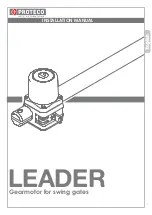
1
PAN15-1
Smart energy plug in switch
This plug-in ON/OFF switch PAN15 is a security enabled wireless switch, based on
Z-Wave Plus technology. Z-Wave Plus
TM
enabled devices displaying the Z-Wave
Plus
TM
logo can also be used with it regardless of the manufacturer, and can also be
used in other manufacturer’s Z-Wave
TM
enabled networks. Remote On/Off control of
the connected load is possible with other manufacturer’s wireless Controller. Each
switch is designed to act as a repeater. Repeaters will re-transmit the RF signal to
ensure that the signal is received by its intended destination by routing the signal
around obstacles and radio dead spots. Because PAN15 supports Security
Command Class, it can learn with Secured controller. Its functionality and supported
command classes is identical when included as a secure and non-secure device.
This plug-in ON/OFF switch is able to detect instance wattage (1560W/UL/TW/JP)
and overload current (14.5A) of connected lights or appliances.
When detecting
overload state, the Switch will be disabled and its On/Off button will be lockout of
which LED will flash quickly. However, unplug and re-connect the switch will reset its
overload condition to normal status.
Adding to Z-Wave
TM
Network
In the front casing, there is an On/Off button with LED indicator which is used to
toggle switch on and off or carry out inclusion, exclusion, reset or association. When
first power is applied, its LED flashes on and off alternately and repeatedly at 0.5
second intervals. It implies that it has not been assigned a node ID and start auto
inclusion.
Auto Inclusion
The function of auto inclusion will be executed as long as the switch does not have
Node ID and just plug the switch into a wall outlet.
Note:
Auto inclusion timeout is 2 minute during which the node information of
explorer frame will be emitted once several seconds. Unlike “inclusion” function as
shown in the table below, the execution of auto inclusion is free from pressing the
On/Off button on the Switch.
The table below lists an operation summary of basic Z-Wave functions. Please refer
to the instructions for your Z-Wave
TM
Certificated Primary Controller to access the
Setup function, and to
Add/Remove
/associate devices
Function
Description
Annotation
No node ID
The Z-Wave Controller does not allocate
a node ID to the Switch.
LED 2-second on, 2-second
off
Add
1.Put your Z-Wave controller into
inclusion mode by following the
instructions provided by the
controller manufacturer.
2. Pressing On/Off button three times
within 2 seconds will enter inclusion
mode.
Remove
1.Put your Z-Wave controller into
exclusion mode by following the
instructions provided by the
controller manufacturer.
1.
Pressing On/Off button three times
within 2 seconds will enter exclusion
mode.
Node ID has been excluded.
LED 0.5s On, 0.5s Off (Enter
auto inclusion)





















